You can connect you guitar amp to your audio interface and start recording your guitar performances in 3 simple steps.
Essentially, all you have to do is link your amp’s line output to your interface’s line input using a TRS cable.
However, there are some important details to know beforehand to avoid damaging your equipment.
This article lays out the 3 steps to safely link your guitar amp to your audio interface – and the cables you need.
We’ll also explain what to do if your amp doesn’t have a line output.
Finally, we’ll discuss the downsides of recording your guitar amp through your audio interface – and provide potentially better one.
Overview
How to Connect your Guitar Amp to your Audio Interface:
Step 1: Identify line input on audio your audio interface
Step 2: Set the gain knob on your audio interface to zero
Step 3: Connect your guitar amp line output to a line input on your audio interface – using a 1/4 inch TRS cable
Obviously, the purpose of connecting your guitar amp to your audio interface is to send guitar signals to your DAW (digital audio workstation).
There are multiple ways to do this…
1. Connect your amp’s line output to a line input on your audio interface
2. Connect amp’s headphone jack to a line input on your audio interface
3. Record your guitar amp through a microphone
We’ll explain how to use each method to record signals from your guitar amp.
How to Connect a Guitar Amp to an Audio Interface in 3 steps
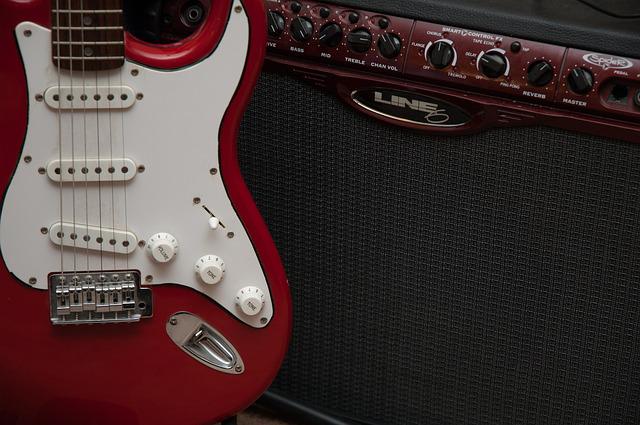
Why Use Line Input on your Audio Interface
To get the cleanest signal, you’ll want to connect your amp line output to a line input on your audio interface.
Many guitar amps have at least one ¼ inch or XLR line output.
When your guitar signal reaches your amp, it’s at instrument level.
Your amp adds gain to your signal, raising it to line-level.
Line outputs send pre-amplified line-level signals to other devices.
As a result, using your amps line output will produce the best sound quality.
Conversely, you can add distortion and possibly damage your equipment by using the mic and instrument inputs instead.
For now, here’s how to connect your amp to your audio interface in three simple steps.
What you Need :
Cable
- ¼-inch Connection: ¼ TRS to TRS Cable
- XLR Connection: XLR Female to TRS Cable
Hardware
- A guitar amp with a line output
- An audio interface with a line input
Step 1: Identify a Line Input on your Audio Interface
First, you’ll want to locate a line-level input on your audio interface.
Some audio interfaces have combo jack inputs – where the outer XLR port is mic-level input, and the inner 1/4 inch port can switch between a line or instrument-level input.
There are also some with dedicated line-level inputs on the back.
Step 2: Set Gain Knob on your Audio Interface to Zero
Before connecting your devices, you’ll want to make sure the gain on your audio interface is set to zero.
Let’s say you want to connect your amp through channel one on your interface.
Identify the gain knob for channel one and turn it all the way to the left.
Step 3: Connect Line Output on your Preamp to Line Input on your Audio Interface
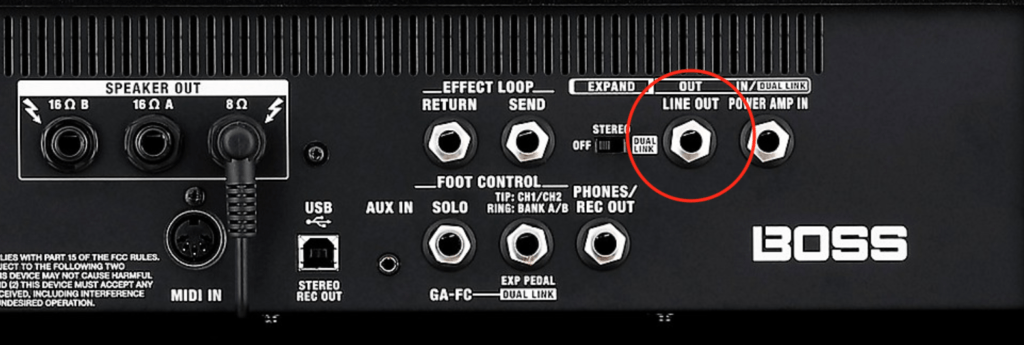
Once you have everything set up, you’re ready to connect your devices.
- Connect one end of your 1/4 inch (or XLR female) cable into your guitar amp line output.
- From there, connect the other end of your cable into a line level input on your audio interface.
Connecting your Amp and Audio Interface to Record in Stereo
Connecting one cable will let you record in mono.
If you want to record your performance in stereo, you’ll need a guitar amp with two line outputs – left and right.
You’ll also need two-line level input on your audio interface.
To record in stereo, follow the same process using two cables instead of one.
- Insert one end of the first cable into the left line output on your amp.
- Insert the other end into the first line input on your audio interface.
- Repeat the same process for the right line output on your amp – connecting it to the second line input on your audio interface.
How to Connect a Guitar Amp to an Audio Interface if you Don’t Have Line Outputs
Some guitar amps don’t have a line output, but they’ll at least have a headphone jack.
You can link your amp’s headphone output to a line input on your audio interface.
In this case, you’ll need a 3.5 mm to 1/4 inch cable.
Why you shouldn’t use Speaker Output to Connect an Amp to an Audio Interface
If your amp doesn’t have line inputs, it can be tempting to use a speaker output instead.
However, this method will likely damage your equipment.
Speaker outputs produce a speaker-level signal.
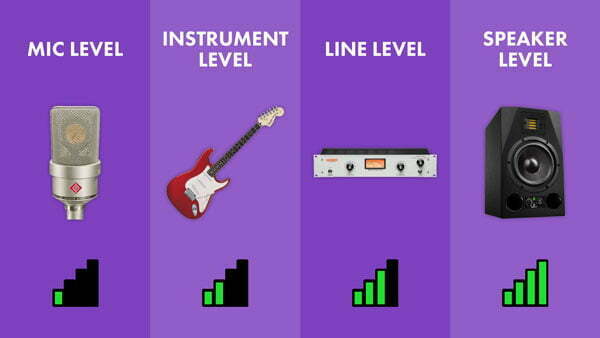
Guitar amps boost speaker level signals through an amplifier to provide speakers with enough voltage to produce sound.
As a result, they’re louder than line-level signals.
However, line inputs in audio interfaces aren’t designed to receive speaker-level signals – they’re too high in voltage.
To avoid damaging your equipment, you’ll want use your amps line out or headphone out.
Why Guitar Amps are Important
An amplifier doesn’t just boost signals from your guitar, it also shapes its tone.
Tone is a widely used term in music to describe the mood, or color, of a sound.
As an electric guitarist, your guitar amp contributes to your signature or desired sound.
Can you Plug your Guitar Directly into an Audio Interface?
You can plug your guitar directly into your audio interface instead of an amp.
However, this method will only capture the dry signal from your guitar.
Luckily, you can use virtual amp simulators to imitate the sound of using a hardware guitar amp.
An amp sim is a plug-in. It lets you alter the tone of your guitar DAW – eliminating the need for a physical amp.
Here are 3 Benefits of using Amp Sims:
1. Saves Money
Amp sims are a great alternative to spending a bunch of money on classic preamps.
2. Saves Space
You won’t need to use up space in your studio storing multiple hardware amps.
3. Convenient
You don’t need to worry about room acoustics and mic placement when recording your amp through a mic.
I’ll explain more about recording your amp through your mic in the next section.
Why the Best Way to Record a Guitar Amp is through a Microphone
Instead of recording your guitar amp through your audio interface, you can record the signal from your amp speaker using a microphone.
This is the best and most popular way to record your amp.
Why?
By recording the output coming from your amp speaker, you’re capturing the tone from your speaker cabinet. – resulting in a better overall sound.
If you’re new to guitar amps, a speaker cabinet is a wooden enclosure that houses your amp’s loudspeaker.
Its size, depth, material, construction style, and other factors affect the sound the speaker produces.
For example, larger cabs produce more bass than smaller ones.
Also, closed-back cabs generate more bass, while open-back cabs create a more airy sound by spreading sounds evenly throughout a room.
The Downsides of Connecting your Amp to your Audio Interface
When you record your amp through your audio interface, you’re bypassing your amp’s cabinet.
In other words, the signal from your guitar won’t be affected by your amp’s cabinet design.
As a result, you’ll sacrifice some of the tonal qualities that make your amp unique.
How to Record your Amp through a Microphone
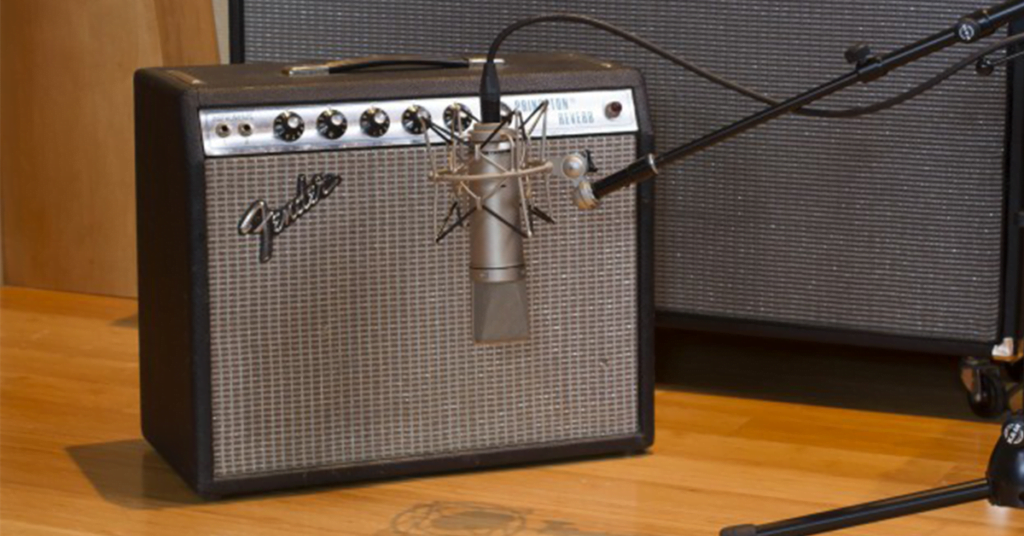
Step 1: Set up your mic on a mic stand
Some of the best mics for recording your amp are the Shure SM57, Sennheiser e609, and Royer 121.
In general, you’ll want the most transparent mic you can afford.
One that’s capable of accurately capturing high and low frequencies from your amp.
Step 2: Connect your mic to your audio interface – and your audio interface to your computer
Step 3: Position your mic in front of your speaker cabinet
Mic placement will play a significant role in the tone of your recording.
Positioning your mic close you’re your speaker will capture your amp’s sound with greater detail.
Conversely. the farther your mic is from your amp, the more it’ll record the reflections in your room, adding a natural reverb.
It’s also common to see guitarists place their mics in the center of their amp for a brighter tone.
The more you move your mic toward the edge of your speaker, your sound becomes increasingly darker.
Step 4: Record
Why you still Need a Speaker Cabinet when Connecting your Amp to your Audio Interface
An audio interface is not a replacement for a speaker cabinet.
Generally, you still need to connect a cabinet to an amp head when using an audio interface.
Why is this the case?
In short, an amp head produces an electrical signal.
The speakers in a cabinet convert this electrical signal into sound.
This is why a cabinet is essential…
It gives this electrical signal generated by your amp head somewhere to go (load).
In other words, it provides a load for the electrical signal.
Without a load, your amp head will overload, causing damage to your equipment.
Connecting Guitar Amp Directly to a Computer
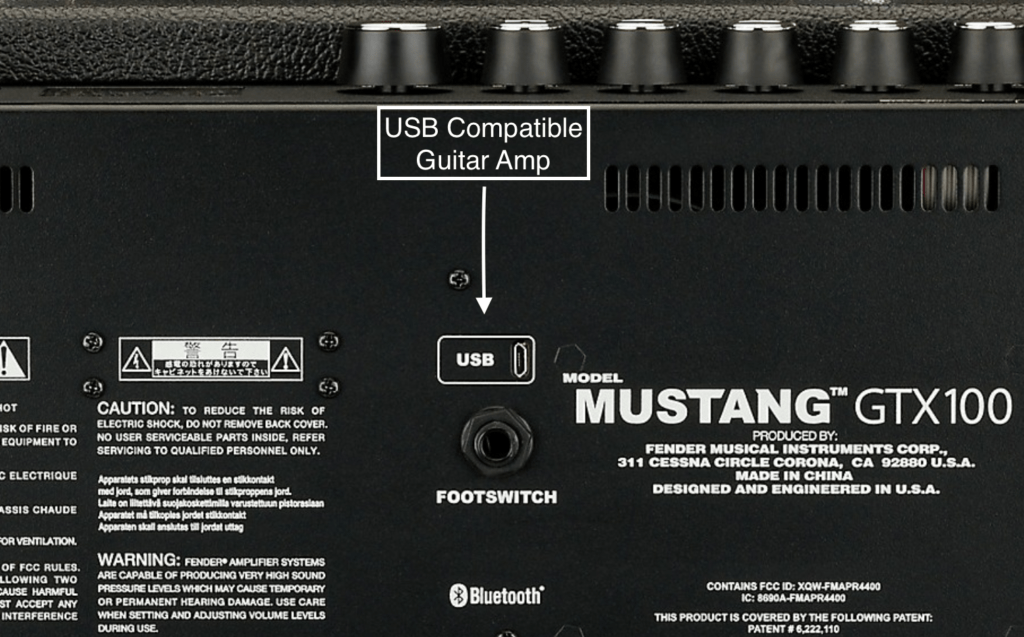
Some guitar amps come with a USB connection.
In this case, you can connect directly to your computer – eliminating the need for an audio interface.
Keep in mind that this method bypasses your amp’s cabinet when recording.
As a result, your recordings will lack some of the character your amp adds.
However, you can use mixing plug-ins to improve sound quality post-production.
Related Questions
How do I Connect my Amp to my Focusrite Interface?
The Focusrite Scarlett 2i2 is one of the most popular audio interfaces.
It’s no surprise that many people ask how to connect it to a guitar amp.
Connecting the 2i2 to an amp is straightforward.
1. Set Input to Line Level
The 3rd generation 2i2 has two combo inputs.
You can switch the inner 1/4 jack between a line and instrument input using the “INST” button.
When the INST button isn’t highlighted, the 1/4 inch input becomes a line-level input.
2. Set Gain
Set the gain for your recording channel on your interface to zero.
3. Connect Devices
Insert one end of your TRS cable into your amps line output.
From there, insert the other end into your audio interface’s line input.
If your amp doesn’t have a line out, you can use its headphone jack instead – using a 3.5 mm to 1/4 inch cable.
Can you Plug Guitar Pedals into an Audio Interface?
Yes, you can plug guitar pedals into an audio interface.
To do so, arrange and daisy chain your pedals – connect them using their inputs and outputs in a specific order.
Then, connect one end of your 1/4 inch cable to your guitar and insert the other end into the input on your first pedal.
From there, connect the output at the end of the daisy chain (of pedals) to a line input on your audio interface.
[Click here to learn how to use a DI box to record your guitar]
Takeaway: How to Connect your Guitar Amp to your Audio Interface
You can connect your amp to your audio interface in 3 simple steps:
1. Find line input on your audio interface
2. Set gain on your recording channel to zero – on your audio interface
3. Connect your amps line output to your audio interface line input using a TRS cable
If your amp doesn’t have a line out, you can also use its headphone out instead. If your use this output, it’s best to use a 3.5mm to 1/4-inch cable.
Keep in mind that when you record your guitar amp through an audio interface, the signal from your guitar will bypass your amp’s speaker cabinet.
Why is this important?
The design of your amp’s speaker cabinet helps shape the tone of your guitar.
To capture the tone of your guitar through your amp’s speaker, you can record your amp through a microphone.
Many people believe this is the best way to record your amp.
If you use this method, how you position your mic in front of the amp and the acoustics in your studio will affect your recordings.
If you run into any issues while connecting your devices, leave a comment, and I’ll assist your as best as I can.








